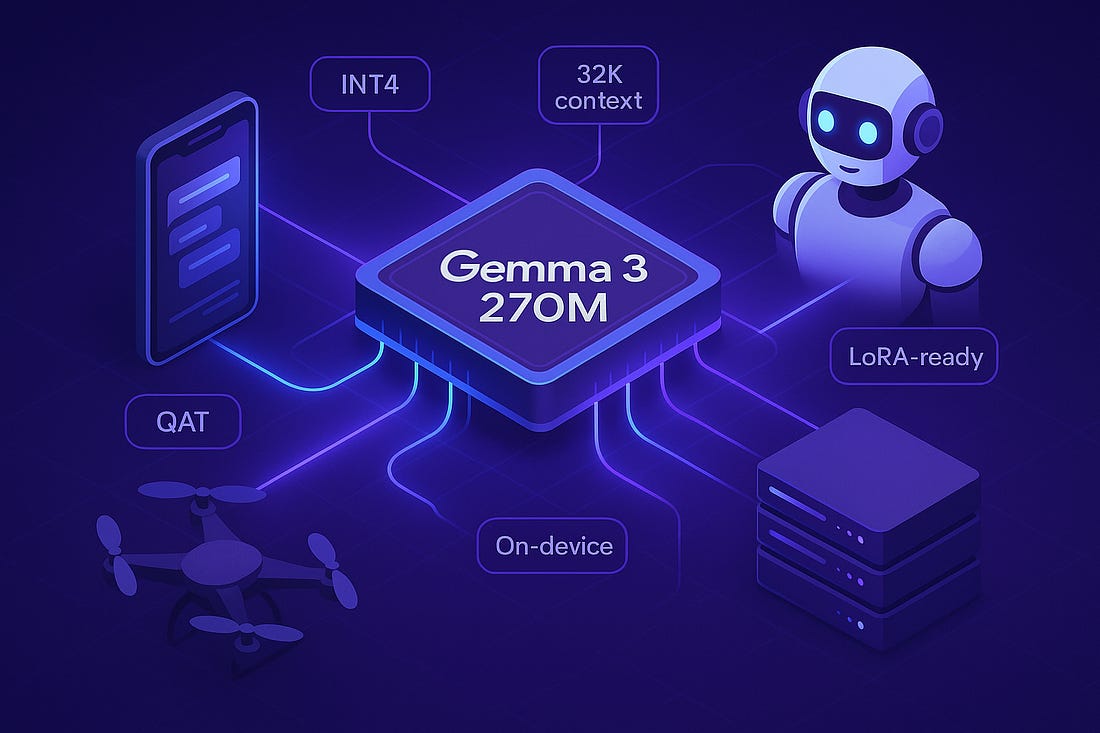The Sequence Radar #704: Tiny Titan: Inside Google's Gemma 3 270M
Was this email forwarded to you? Sign up here The Sequence Radar #704: Tiny Titan: Inside Google's Gemma 3 270MOne of the most impressive small models ever created.Next Week in The Sequence:
Subscribe Now to Not Miss Anything:📝 Editorial: Tiny Titan: Inside Google’s Gemma 3 270MGemma 3 270M is Google’s newest ultra‑compact, open‑weights language model built for edge devices and low‑cost servers. At 270 million parameters, it prioritizes predictable instruction following, structured text generation, and latency over broad, open‑ended conversation. The design premise is simple: many production pipelines benefit more from small, specialized models with tight guardrails than from one generalist assistant. This model slots into that gap, delivering fast, low‑power inference while remaining easy to fine‑tune. Architecturally, Gemma 3 270M is a decoder‑only Transformer optimized for efficiency. It uses grouped‑query attention to shrink KV cache and increase throughput, and applies QK‑norm to stabilize attention logits without expensive soft‑capping. To stretch sequence length without exploding memory, the stack interleaves local and global attention layers so most tokens attend within windows while periodic global layers propagate long‑range signal. In this configuration the model targets a practical 32K context window. A large subword vocabulary (on the order of 256K tokens) shifts a sizable fraction of the parameters into embeddings, intentionally trading deeper blocks for better coverage of rare and domain‑specific tokens. Training follows the broader Gemma 3 recipe: heavy distillation from stronger teacher models, a large multi‑stage pretraining corpus, and instruction tuning aimed at schema compliance. For its size class, the instruction‑tuned checkpoint tends to be competitive on small‑model staples like HellaSwag, PIQA, and ARC and delivers solid zero‑shot adherence on instruction‑following evaluations. The upshot is not state‑of‑the‑art reasoning, but reliable, deterministic outputs that are easy to coerce into fixed formats after a light round of task‑specific SFT or LoRA. The headline is deployment efficiency. Google provides quantization‑aware trained (QAT) checkpoints that hold up well under INT4, enabling very low‑latency inference with minimal quality loss. The runtime surface is broad—llama.cpp‑style CPU back ends, MLX on Apple silicon, Gemma.cpp, and similar accelerators—making it straightforward to target browsers, phones, or micro‑VMs. In practice, the footprint is small enough that you can co‑locate many copies per node, keep KV caches hot, and all but eliminate cold‑start latency for bursty workloads. Developer ergonomics are intentionally simple. Pretrained and instruction‑tuned weights are distributed across mainstream hubs (Hugging Face, Kaggle, Ollama, Docker images, LM Studio), and the docs cover both full‑parameter training and parameter‑efficient paths (LoRA/QLoRA). Because the model is tiny, full‑model fine‑tuning is feasible on commodity GPUs (e.g., a single 16 GB card) with modest batch sizes. Licensing follows the usual Gemma flow: accept the terms, pull artifacts, and drop into your preferred framework. Where does it fit? Choose Gemma 3 270M when the task is well defined and evaluable—entity and PII extraction, safety and policy labeling, query intent routing, codebase‑specific linting, compliance redaction, or offline utilities that need deterministic scaffolds. Pair its long context and large vocabulary with a thin SFT layer to lock in schemas and reduce hallucinations, then quantize for production‑grade latency on edge devices. For multi‑capability assistants, tool‑use orchestration, or vision‑heavy pipelines, step up to 1B–27B siblings; for lean, reliable, and cheap inference at scale, 270M is a compelling default. 🔎 AI ResearchGrove MoE: Towards Efficient and Superior MoE LLMs with Adjugate ExpertsAI Lab: Inclusion AI, The Chinese University of Hong Kong, Renmin University of China, Zhejiang University, Shanghai Jiao Tong University, Westlake University MolmoAct: Action Reasoning Models that can Reason in SpaceAI Lab: Allen Institute for AI, University of Washington UserBench: An Interactive Gym Environment for User-Centric AgentsAI Lab: Salesforce AI Research, University of Illinois Urbana-Champaign AutoCodeBench: Large Language Models are Automatic Code Benchmark GeneratorsAI Lab: Hunyuan Team, Tencent Train Long, Think Short: Curriculum Learning for Efficient ReasoningAI Lab: King Abdullah University of Science and Technology (KAUST), Massachusetts Institute of Technology (MIT), Princeton University Dion: Distributed Orthonormalized UpdatesAI Lab: Microsoft Research, Harvard University 🤖 AI Tech ReleasesNVIDIA Robotics StackNVIDIA released new models and environments for robotic applications. Mistral Medium 3.1Mistral open sourced a new version of its Mistral Medium model with strong capabilities in creative writing, tool usage and others. Claude 1M TokensAnthropic announced that Claude Sonnet 4 supports 1M token context. POMLMicrosoft open sourced POML, a new markup language for prompts. DINOv3Meta released DINOv3, its computer vision model based on self-supervised learning methods. 📡AI Radar
You’re on the free list for TheSequence Scope and TheSequence Chat. For the full experience, become a paying subscriber to TheSequence Edge. Trusted by thousands of subscribers from the leading AI labs and universities. |
Similar newsletters
There are other similar shared emails that you might be interested in:


